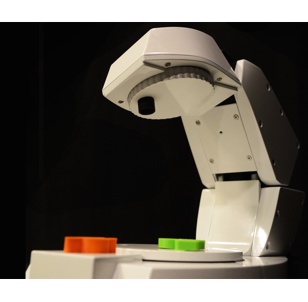| Vyo - A Robot For Controlling Smart Home Devices |
| Written by Lucy Black | |||
| Saturday, 18 June 2016 | |||
|
How do you expect to control your smart home? The choices are growing all the time. The latest on the scene is a weird looking robot that uses "phicons" for communication. Vyo has an impressive pedigree . Described on its web page as a "superintendent social robot", it comes from a collaboration between the IDC Media Innovation Lab (milab), Cornell Human-Robot Collaboration & Companionship Lab (HRC^2), and SK Telecom, all important players in the field. While social robots such as Pepper and the new Asus Zenbo have faces that are humanoid to a greater or lesser degree, Vyo doesn't have a face. When it moves it looks more like a strange glove puppet consisting of a short forearm, a wrist and a balled fist. Emerging smart home control systems, such as Amazon Echo and the new Google Home Personal Assistant, rely mainly on voice, rather than the screen-based commands of earlier systems. Humans give Echo verbal commands and it provides feedback using speech. Other systems, such as Sense, under production from Andreas Gal's new start up Silk Labs, include gesture as a way for humans to signal their wishes. In the case of Vyo gesture is used by the robot to communicate with humans and the humans use coloured tokens or "Phicons" - physical icons - to give instructions to Vyo and its display provides feedback. For example, users can turn on their boilers by putting a red Phicon with the shape of “fire” on Vyo and turn them off by removing the Phicon. When they move the red Phicon from side to side, Vyo adjusts the temperature accordingly providing relevant information. This video is a brief introduction to the this use of Phicons for interaction. The others on Vyo's tray, its status area, are a black one with the shape of key for security devices, including door lock and closed-circuit television (CCTV), and a green one with the shape of glass for dish washer. The blue Phicon with the shape of snowflake, not in use, is for an air conditioner.
From this video you get the impression that Vyo is constantly curious, using its camera to monitor what is happening. You also see it in two modes - calm and agitated. Vyo becomes agitated when something is wrong and signals this through movement. Vyo's behaviour when it is stressed is described in this longer video by its designer Professor Guy Hoffman as "breathing heavily" and "looking around for help":
You'll notice from this video that Vyo is capable of understanding voice commands and of providing spoken feedback and it makes you wonder why it doesn't shout out in an emergency? Personally I would prefer an alarm to sound before the start of a fire rather than when it was already raging but Vyo has been designed with the following five principles and shouting would go against at least two of them - unobtrusive and respectful.
These points are listed in a paper, "Designing Vyo, a Robotic Smart Home Assistant: Bridging the Gap Between Device and Social Agent,” by Michal Luria, Guy Hoffman, Benny Megidish, Oren Zuckerman, and Sung Park from IDC Herzliya, Cornell, and SK Telecom that will be presented at IEEE/RAS RO-MAN 2016 in August. It is the third of them that I find most surprising. Robots like Nao, Pepper, Jibo, Buddy, Zenbo and even Antbo, the ant like robot, are being designed to have a role that includes entertaining children and providing companionship - a pet that cares for humans rather than the other way around. Deciding instead to concentrate on robot that is more device-like seems to be bucking a trend.
More InformationRelated ArticlesGoogle Home Your Personal Assistant New Products For Amazon's Alexa Jibo The Friendly Robot Could Be Your Next Platform Pepper - Aldebaran's New Robot Designed To Be Your Friend ASUS Unveils Zenbo Home Companion Robot Buddy Your Social Robot Has An SDK
To be informed about new articles on I Programmer, sign up for our weekly newsletter, subscribe to the RSS feed and follow us on Twitter, Facebook, Google+ or Linkedin.
Comments
or email your comment to: comments@i-programmer.info |
|||
| Last Updated ( Saturday, 18 June 2016 ) |



